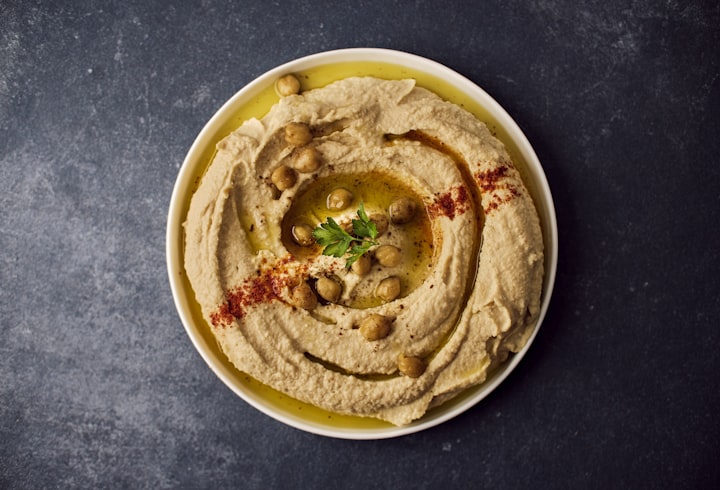"The Evolution of Hummus: From Ancient Staple to Global Delicacy"
"Exploring the Cultural Significance and Culinary Versatility of a Middle Eastern Classic"

Hummus is a delicious and versatile dish that has been enjoyed for centuries in Middle Eastern and Mediterranean cuisines. Made primarily from cooked, mashed chickpeas (also known as garbanzo beans), tahini (a paste made from sesame seeds), olive oil, lemon juice, garlic, and salt, hummus is known for its creamy texture and rich, savory flavor.
This ancient dish has its roots in the Middle East, where it has been a dietary staple for thousands of years. The exact origins of hummus are unclear, but it is believed to have originated in Egypt or the Levant region (which includes modern-day Israel, Palestine, Lebanon, Jordan, and Syria). Hummus was traditionally made by hand, using a mortar and pestle to grind the cooked chickpeas into a smooth paste, which was then mixed with tahini, olive oil, and other ingredients.
Today, hummus is enjoyed around the world and has become a popular dip, spread, and condiment in many different cuisines. It is commonly served as an appetizer or snack, often accompanied by pita bread, crackers, or raw vegetables for dipping. Hummus can also be used as a topping for sandwiches, wraps, salads, and even pizza, adding a burst of flavor and creaminess to any dish.
One of the reasons hummus has become so beloved is its nutritional benefits. Chickpeas are a rich source of protein, fiber, vitamins, and minerals, making hummus a nutritious and satisfying addition to any meal. Tahini, another key ingredient in hummus, is also packed with nutrients, including healthy fats, calcium, and iron.
In addition to its nutritional value, hummus is also incredibly versatile and can be customized to suit any taste or dietary preference. While traditional hummus is made with chickpeas, tahini, and garlic, there are countless variations and flavor combinations to explore. Some popular variations include roasted red pepper hummus, roasted garlic hummus, spicy hummus, and olive hummus, just to name a few.
Making hummus at home is surprisingly simple and requires just a few basic ingredients and a food processor or blender. By experimenting with different ingredients and flavorings, you can create your own signature hummus recipes that are sure to impress family and friends.Hummus, a darling Center Eastern dish, has gone through a momentous development throughout the long term, changing from a modest staple of old food to a commended worldwide delicacy delighted in by individuals all over the planet. Its process mirrors the convergence of culture, history, and culinary development, featuring the persevering through allure and flexibility of this famous dish. Beginning in the Center East, hummus has a rich and celebrated history that goes back millennia. Its accurate starting points are covered in secret, however antiquarians accept that early adaptations of hummus were appreciated by antiquated developments like the Egyptians, Greeks, and Romans. Produced using straightforward fixings like chickpeas, sesame glue (tahini), olive oil, and flavors, hummus was a dietary staple for these old societies, valued for its healthy benefit, flexibility, and delectable flavor. Over the long run, hummus spread all through the Center East, turning into a foundation of local food in nations like Lebanon, Syria, Israel, and Palestine. Each culture put its own special twist on the dish, integrating nearby fixings and flavors to make particular varieties of hummus that mirrored the variety of the area. In the late twentieth and mid 21st hundreds of years, hummus encountered a flood in fame on the worldwide stage, pushed by variables like globalization, migration, and changing dietary patterns. As individuals turned out to be more bold in their culinary interests and more mindful of the medical advantages of plant-based food varieties, hummus arose as a famous decision for wellbeing cognizant customers searching for nutritious and tasty options in contrast to customary plunges and spreads. Today, hummus is appreciated by individuals of all foundations and societies all over the planet, from the roads of New York City to the business sectors of Tokyo. Its flexibility goes with it a most loved decision for all that from plunging vegetables and pita bread to spreading on sandwiches and wraps. Besides, the ascent of the plant-based development has additionally filled the ubiquity of hummus, as purchasers search out sound, protein-rich options in contrast to creature items. Notwithstanding its culinary allure, hummus has likewise turned into an image of social trade and solidarity, uniting individuals across borders and spanning social partitions. Its far and wide ubiquity has ignited a worldwide exchange about food, character, and legacy, empowering individuals to investigate new flavors and embrace different culinary practices. All in all, the development of hummus from old staple to worldwide delicacy is a demonstration of the persevering through allure of this notorious dish. Its rich history, delightful flavor, and wholesome advantages have made it a darling #1 among food devotees around the world. Whether delighted in as a straightforward tidbit or as a feature of a connoisseur dinner, hummus keeps on charming taste buds and rouse culinary imagination, demonstrating that great food knows no limits.
Whether enjoyed as a snack, appetizer, or meal accompaniment, hummus is a delicious and nutritious dish that brings people together around the table. So next time you're looking for a healthy and satisfying snack, why not whip up a batch of homemade hummus and enjoy the creamy goodness of this beloved Middle Eastern classic?
About the Creator
Nameless writer
"A weaver of words, crafting tales that dance on the edge of reality, inviting readers to lose themselves in the symphony of imagination"






Comments
There are no comments for this story
Be the first to respond and start the conversation.